With 2017 over, we reflect on some of the behaviors, attitudes and trends we saw during the year, when it comes to us as consumers and our relationship with energy, as well as our relationship with our energy providers.
Against an increasingly dynamic energy backdrop here are our top ten energy consumer insights from 2017– five from our market data [1], and five from Enervee’s Marketplace data [2]:
1. Efficiency still costs, right?
48% of US consumers still think it costs more to make a super energy efficient choice when buying new appliances or products for their home. They’re wrong. Yes, there are super efficient appliances that can cost more, but the correlation between efficiency and price is not what almost half of US consumers assume it to be. Efficiency does not need to cost more.
2. US energy companies are more credible than their European counterparts.
Well, when it comes to providing information on efficient product and appliance costs. In the US, energy providers are trusted more than manufacturers, retailers and the government (27% of consumers rank them first). In Europe, manufacturers take top spot. With an increasing focus on engaging consumers on energy, US utilities seem well positioned.
3. But buying efficient products and appliances from your utility is still off the cards.
Whilst giving information is good, becoming a retailer is seen as a bad idea — both in the US and Europe. Only 21% of consumers in the US would buy this way, and only 18% in Europe. This points to utilities — in both territories — needing to find an engagement model that separates energy efficiency guidance and enabling from out and out retailing.
4. Energy companies — time to power up on the advice.
Utilities everywhere are expected to step-up to the plate and help us save energy in 2018. In the US, 60% of consumers agree strongly this is part of their utility’s role, with the numbers climbing higher still in Europe: France (76%) and the UK (74%). But that expectation is not being met — only 10% of consumers in the US believe their utility is meeting this increasingly important demand. It’s a similar picture across Europe, with the exception of France, where nearly 40% of consumers think their utility is on track — nice work, EDF (and Enervee client!).
5. Energy efficiency is a nice to have, right?
Wrong (again). It seems for consumers everywhere, energy efficiency is going toe to toe as a key product attribute, alongside price and consumer reviews. Product energy efficiency now ranks as crucial for 40% of US consumers (alongside price for 49% of consumers). In Europe, it’s key for 50% of consumers in France, Germany and the UK, and for 80% of consumers in Italy.
6. Utilities — want to spend more time with your customers? How about being able to double the time, right off the bat?
Accenture reported in 2016 that consumers have on average 40 seconds of contact with their utility per month. When utilities are looking to ramp-up engagement, it’s a tough starting-point. But energy efficient buying looks like a better meeting point — consumers spend on average 1'49" per visit on Marketplace — that’s well over twice the current monthly engagement level, just from one visit.
7. Buying behavior is changing.
Enervee set-out to change our collective buying behavior when it comes to energy efficient products and appliances, and it seems to be working. Having revealed that efficient appliance prices can vary as much as hotel rooms and plane tickets, 2017 saw more than 50,000 profiles created on client Marketplaces, allowing those consumers to make sure they got the best deals on the best products.
8. Efficiency — is it a man thing or a woman thing?
Data from our client Marketplaces reveals that users are more than twice as likely to be men (across all age groups). This is counterintuitive, considering most surveys show women as being more engaged in the energy efficiency topic.
9. Millions of purchase decisions influenced.
Over 2017, Enervee intervened in 2.5million purchase decisions, as a result of being able to reach almost 16% of all US households by the end of the year (as well as over 13% of European households). As a one-time behavior change intervention, the potential to deliver recurring energy savings (over the lifetime of products and appliances purchases) with minimum effort and zero impact on consumer lifestyle, is very large indeed, and getting bigger.
10. Efficiency gets more efficient, with most popular products in leading categories having an average Enervee Score of 97/100.
With Enervee’s unique Enervee Score (a 0–100 ranking of products based on their relative energy efficiency), we’re able to see which products are the most popular across our client Marketplaces. For 2017, it seems, based on the most popular products, consumer interest on our platform is very efficient. Most popular dishwasher: Fisher & Paykal (Enervee Score 99), most popular clothes dryer: LG (Enervee Score 93), most popular freezer: Danby (Enervee Score 100), and most popular refrigerator: Bosch (Enervee Score 96).
[1] Enervee’s Energy Consumer Tracker Survey, 2017
[2] Enervee Marketplace user data (aggregated across US and EU deployments), 2017
